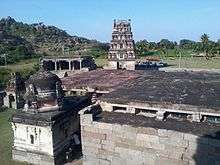Avanibhajana Pallaveshwaram temple
Avanibhajana Pallaveshwaram temple also called Stambeswarar Temple is a Hindu temple dedicated to Shiva, located in the town of Seeyamangalam, Tiruvannamalai district in Tamil Nadu, India. The temple is constructed in Rock-cut architecture by the Pallava king Mahendravarman I (600-630 CE) during the 7th century. The cave temple had later additions from the Chola and Vijayanagar Empire.
| Avanibhajana Pallaveshwaram temple | |
|---|---|
 Image of the temple campus | |
| Religion | |
| Affiliation | Hinduism |
| District | Tiruvannamalai |
| Deity | Stambeswarar(Shiva) |
| Location | |
| Location | Seeyamangalam |
| State | Tamil Nadu |
| Country | India |
 Location in Tamil Nadu | |
| Geographic coordinates | 12°25′52″N 79°27′59″E |
| Architecture | |
| Type | Rock-cut architecture |
One of the pillars has a sculpture of Nataraja, believed to be the earliest representation of the deity in South India. The temple has a small three-tiered rajagopuram, the entrance tower. The temple is declared as a heritage monument and administered by the Archaeological Survey of India as a protected monument. The other side of the hillock houses the Jain beds established in the 9th century during the reign of Ganga King Rajamalla II.
History
Stambeswarar temple was built during the reign of Pallava king Mahendravarman I (600-630 CE) during the 8th century. It is one of the earliest representations of Rock-cut architecture. The place is called Avanibhajana Pallaveshwaram temple as Avani is one of the titles of King Mahendravarman.[1][2] Though the image of the lions in the pillars lead to an assumption that the temple might have been possibly been initiated by Simhavishnu, the father of Mahendravarman, the view is not accepted. The inscriptions, accounted in Epigrahia Indica, is written in Sanskrit with Grantha-Pallava alphabet. The inscriptions indicate that it was dug out by Lalitankura, which is similar to that of cave temple in Tiruchirapalli Rock Fort indicating Mahendravarman.[3] The temple had later additions from the Chola and Vijayanagar Empire. The gopuram, the gateway tower is believed to be an addition by the Vijayanagar kings.[1] The other side of the hillock houses the Jain beds established in the 9th century during the reign of Ganga King Rajamalla II.[4]
Architecture
The temple has a three-tiered rajagopuram a set of scattered shrines. The shrine of Stambeswarar is housed in the circular sanctum in a rock cut cave. There is a large pillared hall and narrow pillared Ardhmandapam leading to the cave sanctum. The shrine for Nadi is located outside the pillared hall axial to the central shrine. The sanctum is guarded by two Dvarapalas, the guardian deities. The sanctum houses the image of Shiva in the form of lingam. In the pillars, lotus is carved on the upper portion, while images of lion is seen in the lower half.[5] The presiding deity is called Thoonandavar or Stambeswarar on account of the presence of two pillars in front of the temple.[4] One of the pillars in the temple has one of the earliest representations of Nataraja (the dancing form of Shiva) in Ananda Thandava posture. There are two attendants of Shiva ganas of Nataraja, with one of them playing Miruthangam (a percussion instrument) and other in praying posture. The pillared hall has images of yalis, the mythical creatures representative of Vijayanagar Art.[1] The images of other attendant deities of Shiva are housed in smaller shrines around the sanctum.[6]
Natarja dance posture
Nataraja is the cosmic representation of Shiva's different dance forms. The temple has the earliest representation of Nataraja in sculpture. As per Hindu mythology, Shiva is a violent dancer and while he dances, a snake named Karkodaka winds in his legs, leading to Shiva performing the Bhujamgatrasa, the snake fight posture. The sculpture of Nataraja in the temple depicts the posture.[7] Shiva is sported with four hands, with his one of the left hands showing dola hasta posture, parasu in the second left, Abhaya mudra (protecting posture) in the first right hand and fire in the second right hand. Archeologist Dr.R.Nagaswamy believes that the hooded snake at the foot of Nataraja is the proof of Bhujamgatrasa. It is believed that all forms of dance are derived from Natya Sastra by sage Bharatha and Mahendravarma's knowledge of delicate postures are exemplified in the sculpture. He also affirms that by the image Mahendra shows the connection between bhujaṅga trāsita and that the dance of Nataraja, the cosmic form of Shiva leads to the Ananda.[8]
Worship and religious practices
The temple is declared as a heritage monument and administered by the Archaeological Survey of India as a protected monument.[9] Though it is an archaeological monument, the temple is active in worship practices, where the temple priests perform the puja (rituals) during festivals and on a daily basis. The temple rituals are similar to that of other Shiva temples.[10]
References
- Sharath, Lakshmi (26 January 2012). "The praying caves". Business Line. Retrieved 15 November 2015.
- Chatterjee, Suhas (1998). Indian Civilization and Culture. M.D. Publications Pvt. Ltd. p. 411. ISBN 9788175330832.
- Jouveau-Dubreuil, Gabriel; Dikshitar, V. S. Swaminadha (1995). The Pallavas. Asian Educational Services. p. 35. ISBN 9788120605749.
- "Seeyamangalam". C.P.R. Environmental Education Centre, Chennai. 2011. Retrieved 16 November 2015.
- Jouveau-Dubreuil, Gabriel (1994). Pallava Antiquities - 2 Vols. Asian Educational Services. pp. 33–35. ISBN 9788120605718.
- Sewell, Robert (1882). Lists of the Antiquarian Remains in the Presidency of Madras, Volume 1. E. Keys. p. 170.
- D., Dennis Hudson (2008). The Body of God : An Emperor's Palace for Krishna in Eighth-Century Kanchipuram: An Emperor's Palace for Krishna in Eighth-Century Kanchipuram. Oxford University Press, USA. p. 201. ISBN 9780199709021.
- Dr.R., Nagaswamy. "Royal patronage to dance and music The pallava mārga". Tamil Arts Academy. 18. Retrieved 15 November 2015.
- "List of Monuments and Sites: Vellore sub-circle". Archaeological Survey of India. 2011. Retrieved 15 November 2015.
- C., Dr.Chandramouli (2003). Temples of Tamil Nadu - Kancheepuram district. Chennai: Directorate of Census Operations, Tamil Nadu.
